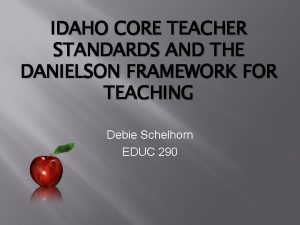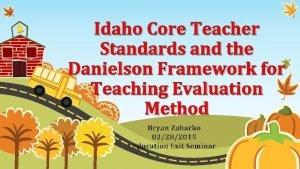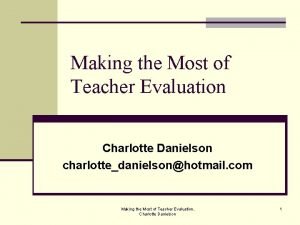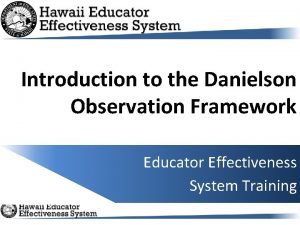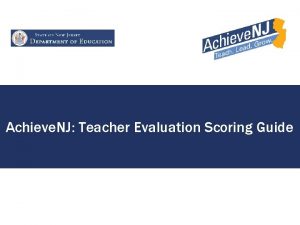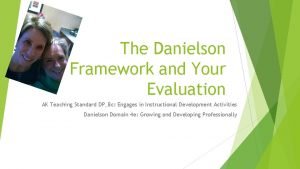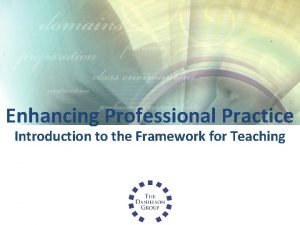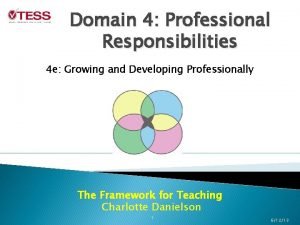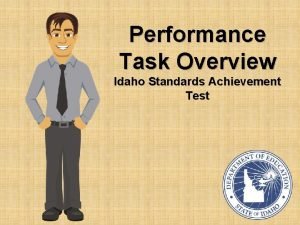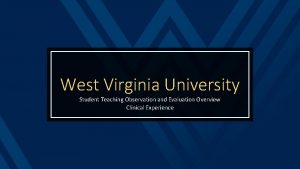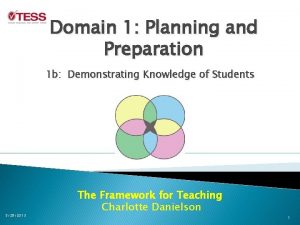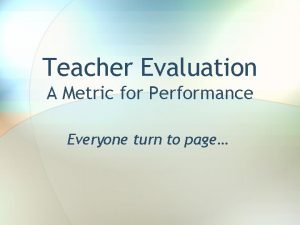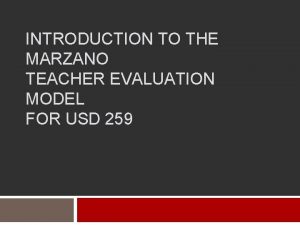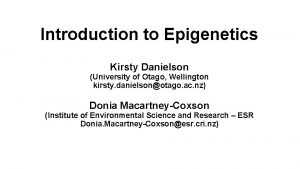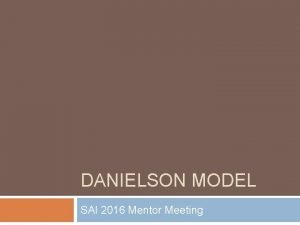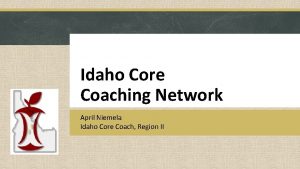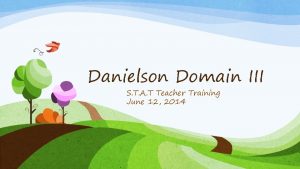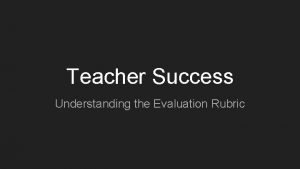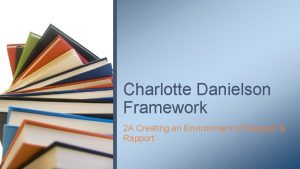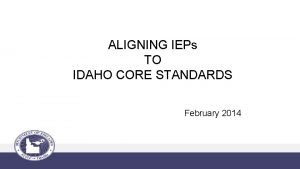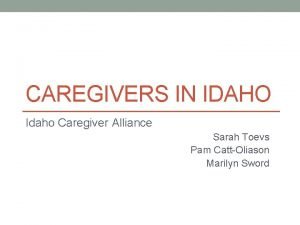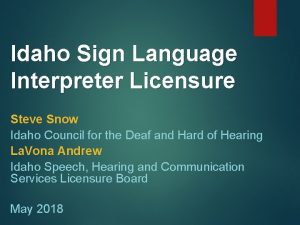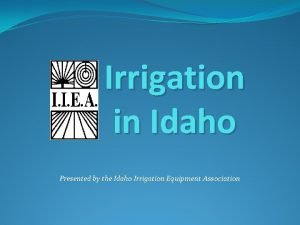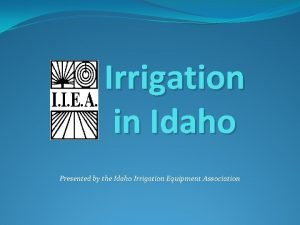Idaho Core Teacher Standards Danielson Framework for Teaching





















- Slides: 21

Idaho Core Teacher Standards & Danielson Framework for Teaching By: Shelbe Balls

What are the Idaho Core Teacher Standards? • The Idaho Core Teacher Standards are 10 standards that apply to all teacher certification areas. • They are the 10 basic standards that all teachers must know and be able to apply in their classroom regardless of their specific content area. • They are grouped into 4 categories: • 1. The Learner and Learning • 2. Content • 3. Instructional Practice • 4. Professional Responsibility (Idaho State Board of Education, 2013, p. 2)

Standard #1: Learner Development • The teacher understands how learners grow and develop, recognizing that patters of learning and development vary individually within and across the cognitive, linguistic, social, emotional, and physical areas, and designs and implements developmentally appropriate and challenging learning experiences. What Does This Mean? ? How will I use this? • As a teacher I will regularly asses my students in both individual and group performance. • I will use my students strengths and interests to help develop appropriate instruction for my students. (Idaho State Board of Education, 2013, p. 7)

Standard #2: Learning Differences • The teacher uses understanding of individual differences and diverse cultures and communities to ensure inclusive learning environments that enable each learner to meet high standards. What Does This Mean? ? How will I use this? • If a student has a learning disability, I as the teacher will make appropriate time provisions for them. • I will use the prior knowledge and experiences of my students to help me design appropriate instruction. (Idaho State Board of Education, 2013, p. 8)

Standard #3: Learning Environments • The teacher works with others to create environments that support individual and collaborative learning, and that encourage positive social interaction, active engagement in learning, and self-motivation. What Does This Mean? ? How will I use this? • I will create a learning environment that is safe and positive for all learners and their families. • I will use many different methods to help my students engage in their learning. (Idaho State Board of Education, 2013, p. 9)

Standard #4: Content Knowledge • The teacher understands the central concepts, tools of inquiry, and structures of the discipline(s) he or she teaches and creates learning experiences that make the discipline accessible and meaningful for learners to assure mastery of the content. What Does This Mean? ? How will I use this? • I will encourage my students to understand, question, and analyze the content to help them master it. • I will use my school and district based resources to help me evaluate my students knowledge. (Idaho State Board of Education, 2013, p. 11)

Standard #5: Application of Content • The teacher understands how to connect concepts and use differing perspectives to engage learners in critical thinking, creativity, and collaborative problem solving related to authentic local and global issues. What Does This Mean? ? How will I use this? • I will try to relate what I am teaching my students to their everyday life to help them have a better understanding of the content. • I will question and challenge my students on the content I am teaching them to help them gain problem solving strategies. (Idaho State Board of Education, 2013, p. 12)

Standard #6: Assessment • The teacher understands and uses multiple methods of assessment to engage learners in their own growth, to monitor learner progress, and to guide the teacher’s and learner’s decision making. What Does This Mean? ? How will I use this? • I will model processes in a way that makes the student use their own thinking and learning. • I will continually seek ways to use technology in the classroom to help engage students in learning. (Idaho State Board of Education, 2013, p. 15)

Standard #7: Planning for Instruction • The teacher plans instruction that supports every student in meeting rigorous learning goals by drawing upon knowledge of content areas, curriculum, crossdisciplinary skills, and pedagogy, as well as knowledge of learners and the community context. What Does This Mean? ? How will I use this? • I will collaborate with professionals who have specialized expertise to help design and deliver unique learning experiences. • I will help students evaluate a plan for short term and long term goals. (Idaho State Board of Education, 2013, p. 17)

Standard #8: Instructional Strategies • The teacher understands and uses a variety of instructional strategies to encourage learners to develop deep understanding of content areas and their connections, and to build skills to apply knowledge in meaningful ways. What Does This Mean? ? How will I use this? • I will continually monitor and asses my students learning and will adjust my instructional material in response to what I see and gather. • I will use a variety of instructional strategies to help support and expand my students communication through many different methods (writing, reading and listening). (Idaho State Board of Education, 2013, p. 18)

Standard #9: Professional Learning and Ethical Practice • The teacher engages in ongoing professional learning and uses evidence to continually evaluate his/her practice, particularly the effects of his/her choices and actions on others (learners, families, other professionals, and the community), and adapts practice to meet the needs of each learner. What Does This Mean? ? How will I use this? • I will advocate, model and teach safe, legal and ethical information to my students. • I will actively seek professional, community and technological resources. (Idaho State Board of Education, 2013, p. 20)

Standard #10: Leadership and Collaboration • The teacher seeks appropriate leadership roles and opportunities to take responsibility for student learning, to collaborate with learners, families, colleagues, other school professionals, and community members to ensure learner growth, and to advance the profession. What Does This Mean? ? How will I use this? • I will work with my school colleagues to help build ongoing connections that will help with student learning. • I will advocate to meet the needs of my students and help strengthen their learning environment. (Idaho State Board of Education, 2013, p. 21)

How do these affect me as an Educator? • As an educator I must be able to understand all of the standards and what is expected of me as an educator. • I must be able to use and demonstrate them within my classroom. • My administrators will evaluate me based on how well I can comprehend the standards and apply them to my job.

What is the Danielson Framework for Teaching? • The Framework for Teaching is a set of research-based components of instruction. • These components have been aligned to the Interstate New Teacher Assessment and Support Consortium (INTASC) standards and they have been broken down into 22 components and grouped into four domains of teaching responsibility. ("Danielson Group » The Framework, " 2013)

Domain 1: Planning and Preparation • 1 a Demonstrating Knowledge of Content and Pedagogy • 1 b Demonstrating Knowledge of Students • 1 c Setting Instructional Outcomes • 1 d Demonstrating Knowledge of Resources • 1 e Designing Coherent Instruction • 1 f Designing Student Assessments ("Danielson Group » The Framework, " 2013)

Domain 2: Classroom Environment • 2 a Creating an Environment of Respect and Rapport • 2 b Establishing a Culture for Learning • 2 c Managing Classroom Procedures • 2 d Managing Student Behavior • 2 e Organizing Physical Space ("Danielson Group » The Framework, " 2013)

Domain 3: Instruction • 3 a Communicating with Students • 3 b Using Questioning and Discussion Techniques • 3 c Engaging Students in Learning • 3 d Using Assessment in Instruction • 3 e Demonstrating Flexibility and Responsiveness ("Danielson Group » The Framework, " 2013)

Domain 4: Professional Responsibilities • 4 a Reflecting on Teaching • 4 b Maintaining Accurate Records • 4 c Communicating with Families • 4 d Participating in the Professional Community • 4 e Growing and Developing Professionally • 4 f Showing Professionalism ("Danielson Group » The Framework, " 2013)

The Framework as an Evaluation Tool • When a teacher’s teachers performance is being evaluated using the Frameworks method, the administrator follows a rubric for each of the domains and subdomains in their evaluation. • Teachers are graded on their performance with the following labels: • • Ineffective- Level 1 Developing- Level 2 Effective- Level 3 Highly Effective- Level 4 ("RCSD Teacher Evaluation Guide Supplement - A, "

The Framework as an Evaluation Tool • Here is an example rubric: • http: //www. rcsdk 12. org/cms/lib 04/NY 01001156/Centricity/Domain/6365/T eacher_Eval_Guide_Supplement_A_Danielson_teachscape_rubric_condensed. pdf ("RCSD Teacher Evaluation Guide Supplement - A, "

References • Danielson Group » The Framework. (2013). Retrieved from http: //www. danielsongroup. org/framework/ • Idaho State Board of Education. (2013). Idaho standards for initial certification of professional school personnel. ID: Idaho state department of education. • RCSD Teacher Evaluation Guide Supplement - A. (2011, October). Retrieved from http: //www. rcsdk 12. org/cms/lib 04/NY 01001156/Centricity/Domain/6365/T eacher_Eval_Guide_Supplement_A_Danielson_teachscape_rubric_condensed. pdf
 Danielson framework summary
Danielson framework summary Idaho core teacher standards
Idaho core teacher standards Jane horney
Jane horney Danielson pre observation questions and answers
Danielson pre observation questions and answers Danielson teacher evaluation scores
Danielson teacher evaluation scores Danielson framework
Danielson framework Danielson framework components
Danielson framework components Egrowing
Egrowing Performance task ideas
Performance task ideas 3 components of whmis
3 components of whmis Alrik danielson skf
Alrik danielson skf Karen danielson horney
Karen danielson horney Danielson clusters
Danielson clusters Domain 4 examples
Domain 4 examples Domain 1: planning and preparation examples
Domain 1: planning and preparation examples Karen danielson horney
Karen danielson horney Robert marzano's causal teacher evaluation model
Robert marzano's causal teacher evaluation model Danielson and marzano
Danielson and marzano Danielson and marzano
Danielson and marzano Marzano teacher evaluation
Marzano teacher evaluation Kirsty danielson
Kirsty danielson Meaning of erf in deped
Meaning of erf in deped
